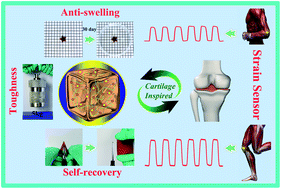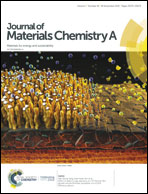Cartilage-inspired hydrogel strain sensors with ultrahigh toughness, good self-recovery and stable anti-swelling properties†
Abstract
Conventional hydrogels inevitably “swell” under liquid or physiological conditions, which drastically destroys their mechanical properties, severely limiting their practical applicability. Here, a cartilage-inspired tough, anti-swelling and conductive hydrogel was designed and successfully fabricated. The hydrogel exhibits splendid mechanical strength of 2.75 MPa and good self-recovery, with a recovery efficiency of 96%. In addition, the hydrogel also has anti-swelling properties in different solutions, including H2O, DMSO, physiological saline, seawater and aqueous solutions with different pH values from 3 to 11. Surprisingly, the mechanical strength of the hydrogel is significantly improved (up to 4.05 MPa) after swelling in H2O for 24 h. Moreover, the presence of dynamic ions (Fe3+, Na+, Cl−) in the system also imparts superior conductivity to the hydrogel, which could accurately monitor human motions (bending of neck, elbow, wrist and knee) as a flexible strain sensor. Therefore, this biomimetic hydrogel should have broad application in various fields in complex environments, for example in electric skin, biosensors, tissue engineering, etc.



 Please wait while we load your content...
Please wait while we load your content...